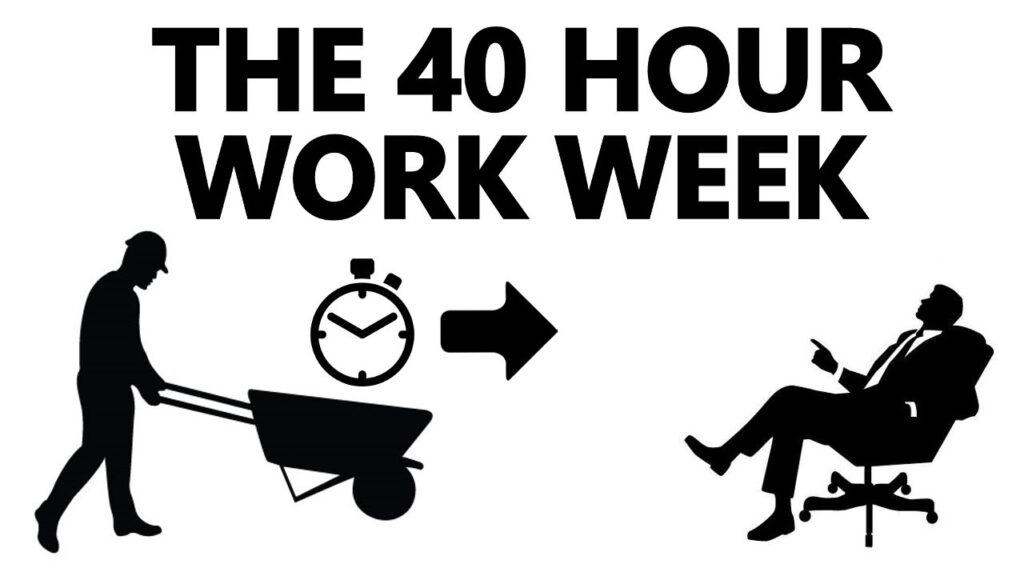The Fallacy of the 40-Hour Workweek: Rethinking Productivity Standards
In the modern world, the 40-hour workweek has become a standard norm for many industries. It’s deeply ingrained in our culture and often considered a benchmark of productivity and commitment. However, in recent years, a growing chorus of voices has begun to question the effectiveness and relevance of this age-old concept.

Is the 40-hour workweek truly the optimal way to achieve productivity, or is it a fallacy that needs to be reevaluated in light of evolving work dynamics? In this blog post, we’ll delve into the rationale behind the 40-hour workweek, its limitations, and the emerging need to reconsider productivity standards.
The Historical Context
The idea of the 40-hour workweek has its roots in the industrial revolution when labor unions advocated for limits on work hours to ensure better working conditions and work-life balance. Back then, the 40-hour workweek was a substantial improvement from the excessive hours people were often required to work. It was a step towards fair treatment of workers and a response to the physically demanding nature of labor-intensive jobs.
The Changing Nature of Work
Fast forward to the present day, and we find ourselves in a vastly different work environment. The advent of technology, automation, and the knowledge economy has shifted the nature of work from manual labor to cognitive tasks. With the rise of remote work and flexible job roles, the traditional 9-to-5 structure may not be the most efficient or productive way to operate.
Quality Over Quantity
Productivity isn’t solely about the number of hours spent at work. It’s about the quality of work accomplished during those hours. With the right focus and mindset, individuals can achieve more in fewer hours, making the argument for a shorter workweek or more flexible scheduling. Consider the phenomenon known as the “flow state.”
This is a mental state in which a person is fully immersed in a feeling of energized focus, full involvement, and enjoyment in the process of the activity. This state often leads to heightened creativity and productivity. By recognizing the value of these high-quality work periods, businesses can create environments that encourage employees to harness their flow states, resulting in a more productive and impactful workday.
Diminishing Returns of Extended Hours
Research suggests that working beyond a certain number of hours per week leads to diminishing returns in terms of output. Long work hours can lead to burnout, reduced creativity, and decreased cognitive function. Therefore, pushing employees to work longer hours might not necessarily result in higher productivity.
In fact, Sweden’s successful experiment with a 6-hour workday in some nursing homes showed not only improved employee well-being but also maintained or even increased productivity levels. This suggests that a well-rested and motivated workforce can achieve similar or better results in less time.
Work-Life Balance and Well-being
The 40-hour workweek often undermines work-life balance, leading to stress and fatigue. A more flexible approach to work hours can promote better mental and physical well-being, ultimately contributing to enhanced productivity.
Companies that embrace flexible work arrangements, including remote work and flexible hours, tend to experience increased employee morale and engagement. When employees have the autonomy to balance their work and personal lives, they are more likely to approach their tasks with renewed energy and enthusiasm.
Rethinking the Workweek
Rethinking productivity standards doesn’t necessarily mean doing away with the 40-hour workweek altogether, but rather, considering a more nuanced approach:
Outcome-Based Productivity: Shift the focus from time spent to outcomes achieved. This approach encourages employees to complete tasks efficiently, leaving room for personal growth and leisure.
Flexible Scheduling: Embrace flexible scheduling that allows employees to work during their most productive hours. This can lead to improved focus, engagement, and overall job satisfaction.
Experimentation and Adaptation: Encourage experimentation with different workweek models, such as a 4-day workweek or compressed work hours. Assess the impact on productivity and employee well-being.
Embracing Technology: Leverage technology to automate repetitive tasks and streamline workflows, potentially reducing the need for longer work hours.
The 40-hour workweek served as a significant step in improving working conditions during its time. However, as our world continues to evolve, so should our approach to productivity. The fallacy lies in the assumption that more hours equate to higher output. By reevaluating productivity standards and focusing on outcomes, well-being, and flexibility, we can pave the way for a more efficient and fulfilling work experience.
It’s time to question the status quo and embrace a new era of work that values productivity in a holistic and meaningful way. Let’s move towards a future where productivity is defined by the quality of work and the well-being of the workforce, rather than the number of hours spent at the desk. Although, this is already happening but many are still bent on the 40-hour workweek like a ritual.
Do you like the article? Please comment, and share with loved ones. You can as well buy me a drink through this link. You can read more about work here.



